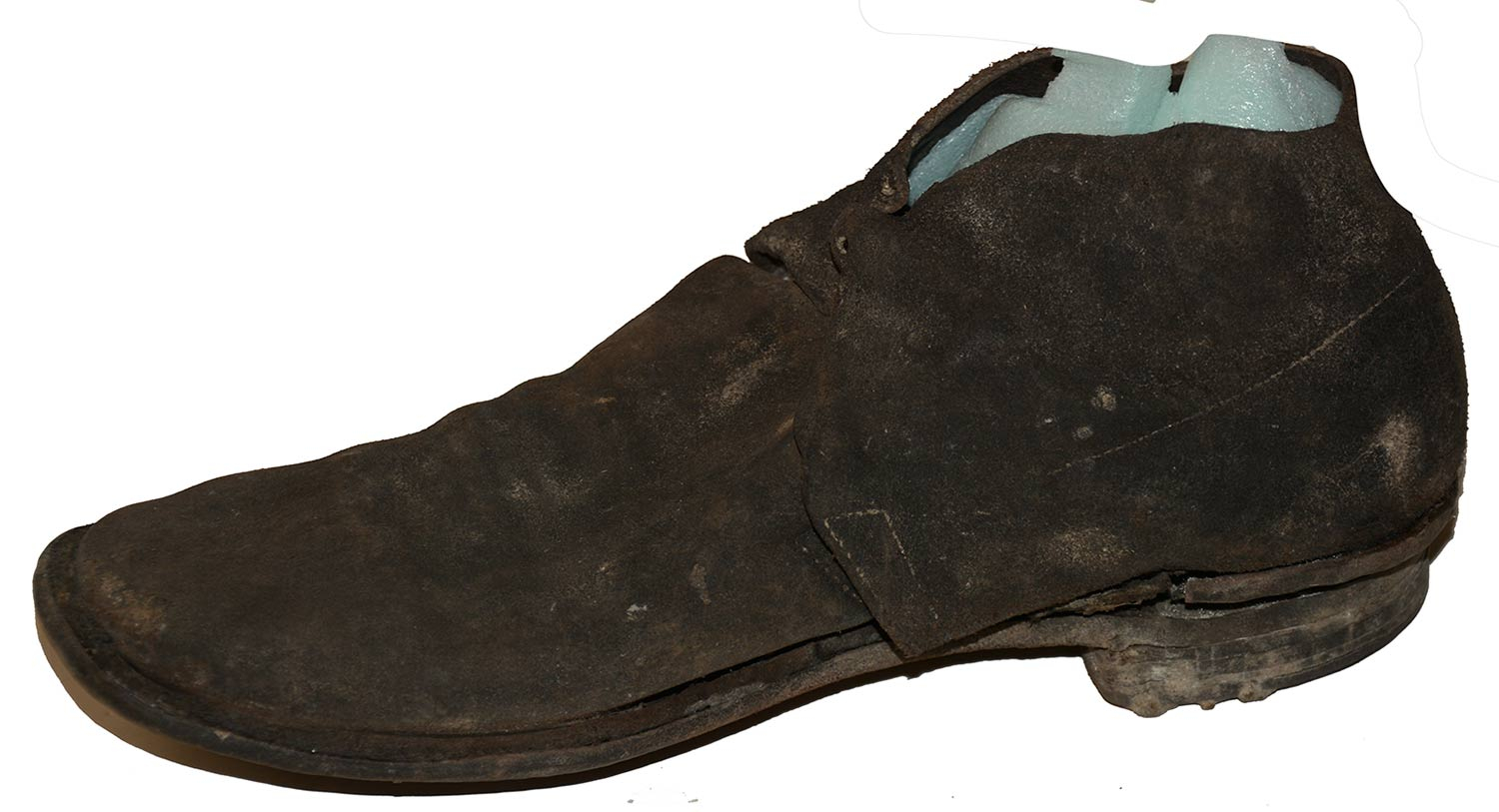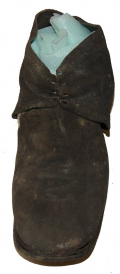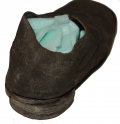site search
online catalog
CIVIL WAR ARMY ISSUE SHOE

$1,250.00 SOLD
Quantity Available: None
Item Code: 1052-299
Civil War army-issue shoes were among the most essential things issued to a soldier and about the rarest of Civil War items to survive despite being made literally in the millions. They were cheaply made, readily worn out on campaign and were discarded and replaced as opportunity offered. After the war surplus stocks sufficed until the army changed patterns in 1872, while those worn home by veterans, being hardly sentimental mementos or inspiring relics of patriotic service, were worn as work shoes if at all and then thrown out.
This is an interesting example, intact and complete except for the shoelace / thong, and is the typical wartime construction as supplied through government depots. The body is rough-side out black leather consisting two-piece uppers (vamp and quarters) that were sewn together low on the instep, with reinforcing “counter” sewn inside the heel, four pairs of holes for a leather thong/lace, square toe, nailed heel and sewn sole - one of the two general Civil War types: pegged or sewn, further broken down by hand or machine made. The leather uppers are stiff, but solid and in good condition, showing some bends or broad wrinkles, but holding their shape. The stitching at the instep holding the vamp and quarters together, however, is gone, allowing quarters, the rear of the uppers, with attached heel portion of the inner sole, to slide back. Inasmuch as it reveals the construction of the shoe, that’s not entirely bad and it displays well when not handled. The counter inside the heel is gone, though the line of the stitching that held it is visible. The tongue is in place in the vamp, though bent over slightly inside. The shoe has four lacing holes on either side. The top hole on the wearer’s right has torn through at the top. The vamp and welt are tight together around the base of the uppers. The forward part of the quarters has pulled away from the welt on the left and the welt is missing for about 2 inches from its front edge along the instep on the right. The heel is composed of four layers secured by nails and is securely attached to the sole. The stitching holes of the sole are clearly visible. The thread is gone. The nails on the heel are good, showing just slight rust.
This was the standard pattern for the army shoe until 1872, when campaigning on the dry and rocky ground of the southwest convinced the army to start using brass screws to secure the soles of shoes and boots. Aside from the missing stitching and loosening of the quarters, the condition is quite good and this would is easily taken as a barn or attic-find from a veteran’s estate, but actually comes from Fort Pembina, ND, established in 1870 by troops who, at that point, were still clothed and equipped with Civil War uniforms and gear from government stocks. Excavations were conducted on private property with owner’s consent and anaerobic soil conditions have yielded cloth and leather gear in remarkable states of preservation. (Think of some of the Roman pieces coming from similar conditions at the British fort of Vindolanda.)
Situated in the Red River Valley in North Dakota near the Canadian border, Ft. Pembina was established in 1870 and in operation until 1895. Trading posts existed earlier in the area as part of the fur trade, and the first U.S. military post there was temporary- manned by a detachment of Minnesota troops in 1863-1864 following the 1862 Sioux uprising. In March 1870 a new fort was established south of the Pembina River and about 200 yards west of the Red River, completed by July and named in honor of Gen. George H. Thomas. The name was changed to Fort Pembina in September and the initial garrison consisted of two companies of the 20th US Infantry. Their main duty was to provide security for settlers worried about Sioux returning south from Canada, but the troops were more occupied with escorting boundary surveys along the Canadian border and preventing Fenian raids heading north into Canada.
The fort included enlistedmen’s barracks, officers’ quarters, guard house, ordnance storehouse, company kitchen, root house, laundress’s quarters, quarters for civilian employees, hospital and hospital servant’s house, a barn for the “hospital cow,” quartermaster and commissary offices and storehouse, stables, wagon shed, etc. The garrison reached peak strength in 1878 af 200, but the average was about 125 enlisted men and 8 officers. An October 1885 return listed 97 men, 2 field pieces, 1 mountain howitzer, 100 rifles, 19 pistols, 23 mules, and 9 wagons. By 1890 the post had just 23 men, and after an 1895 fire destroyed some 19 buildings it was decided to abandon the fort rather than rebuild, the last detachment left in September. The property was turned over to the Interior Department and later sold in 1902.
This is a very scarce piece of Civil War gear in great condition that would add to a Civil War collection and display or one concentrating on the early Indian War frontier army. We recommend “The Army Shoe” by J.E. Tobey in the Columbia Rifles Research Compendium, as well Peterkin’s and other articles in Company of Military Historians, Brinkerhoff’s Boots and Shoes of the Frontier Soldier, and McChristian’s excellent volumes on the postwar US army. [sr] [ph:L]
~~~~~~~~~~~~~~~~~~~~~~~~~~~~~~~~~~~
THIS ITEM, AS WITH ALL OTHER ITEMS AVAILABLE ON OUR WEB SITE,
MAY BE PURCHASED THROUGH OUR LAYAWAY PROGRAM.
CLICK HERE FOR OUR POLICIES AND TERMS.
THANK YOU!
Inquire About CIVIL WAR ARMY ISSUE SHOE
For inquiries, please email us at [email protected]
Most Popular
Historical Firearms Stolen From The National Civil War Museum In Harrisburg, Pa »
Theft From Gravesite Of Gen. John Reynolds »
Selection Of Unframed Prints By Don Troiani »
Fine Condition Brass Infantry Bugle Insignia »
British Imported, Confederate Used Bayonet »
Piece Of Wood From The Room In The White House Where Lincoln Signed The Emancipation Proclamation »
featured item
US MARINE CORPS OFFICER’S ENGLISH MADE MAMALUKE WITH IVORY GRIP
Manufactured: England Maker: Unmarked Year: C1820-25 Model: Mamaluke Size: 35.8 inch blade, 1.21 wide Condition: Excellent+ Tri-color blade - blue, gold and "white" of flat design. Ship's Mast, American Eagle, Standing Indian figure and… (870-76). Learn More »
site search
Upcoming Events
The shop will remain closed to the public through Friday, Jan. 31st, re-opening on Saturday, Feb.… Learn More »









